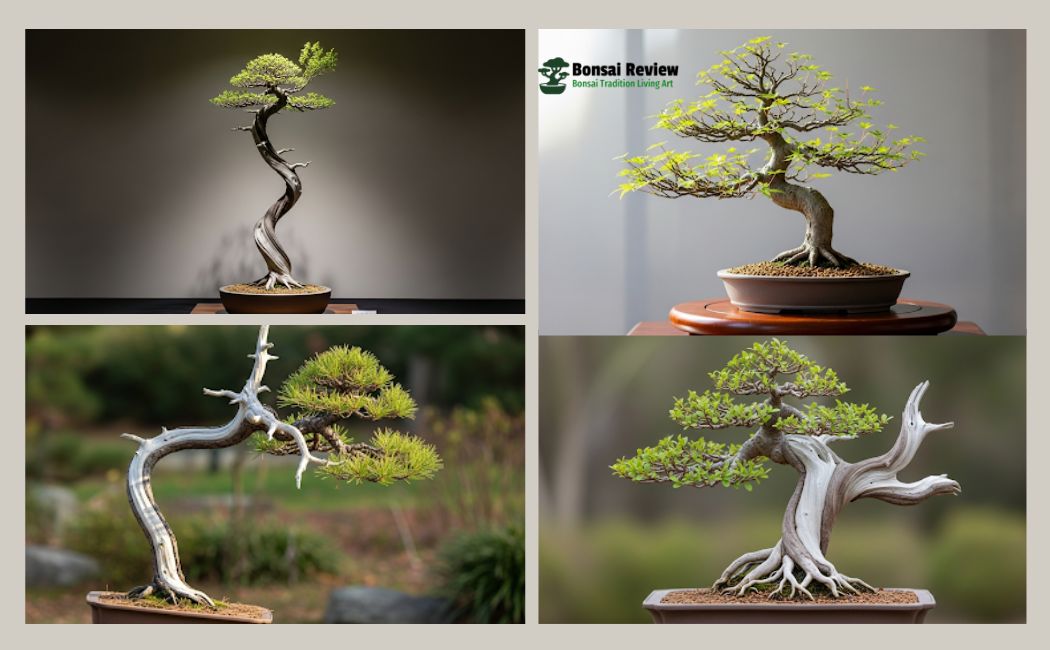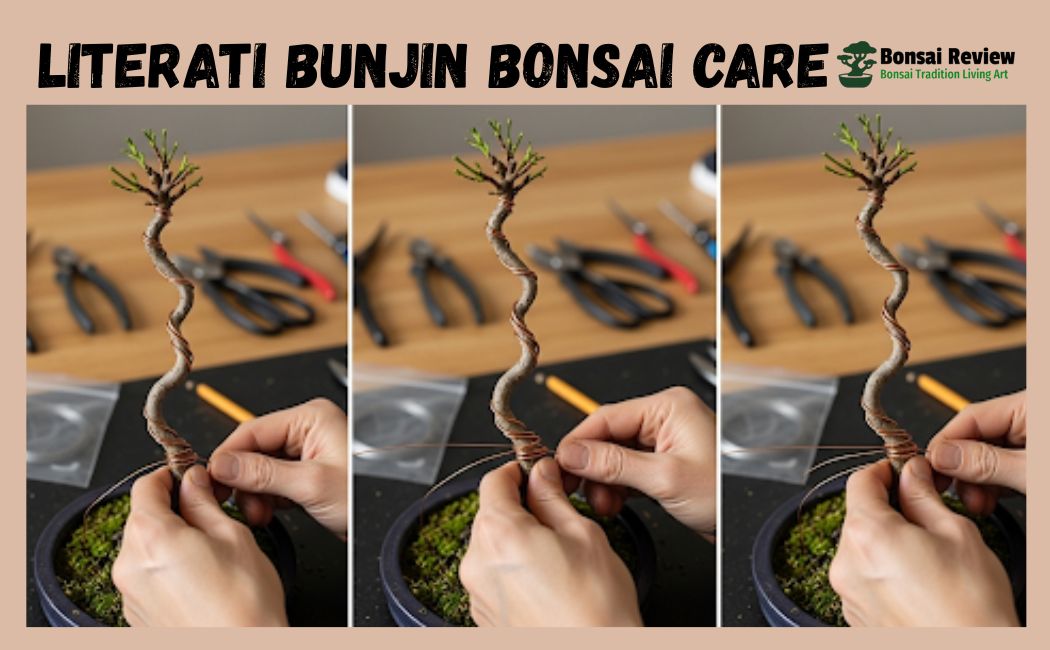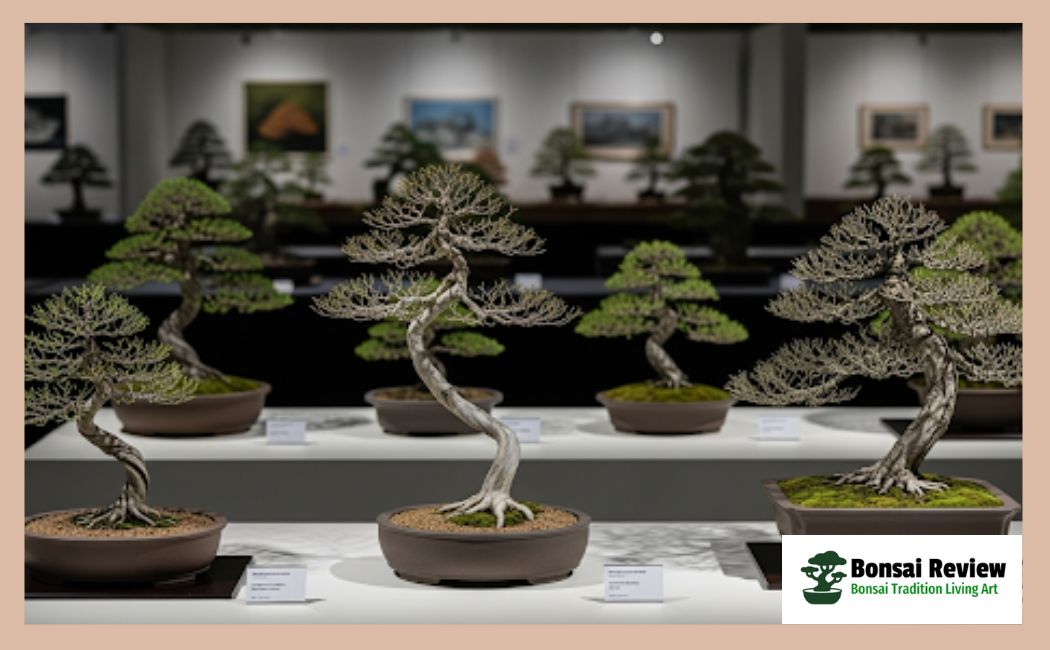Literati Bunjin Bonsai is an artistic, minimalist style characterized by a tall, slender, and often dramatically twisted trunk with sparse foliage concentrated in the upper third of the tree.
Rooted in the appreciation for nature and art held by ancient Chinese literati scholars, this style symbolizes simplicity, subtlety, and empty space to create an elegant, contemplative, and timeless aesthetic.
Have you ever looked at a bonsai tree and thought, “Why does this one look so thin, twisted, and different?” That is the world of the Literati or Bunjin Bonsai, also known as the literati bonsai style.
Many beginners feel confused when they first see it. Most bonsai trees have full crowns, balanced shapes, and neat designs. But the bunjin style bonsai breaks those rules. It shows a tall, slender trunk, often twisted with exposed roots or deadwood (jin, shari), and only a few branches arranged in asymmetry near the top.
This “rule-breaking” is not a mistake. The style comes from Chinese literati culture, where scholars painted trees with long brushstrokes to show freedom and survival.
Later in Japan, artists refined it into the Bunjin bonsai style, tied to wabi-sabi, the beauty of imperfection.
Today, you see bunjin juniper bonsai, bunjin pine bonsai, bunjin maple bonsai, and even flowering types like Ume (Japanese apricot) or Bougainvillea.
If your problem is wondering how to recognize or create this style, the solution is simple: understand its meaning first.
The bunjin bonsai meaning is about resilience, elegance, and artistic freedom, not strict balance. With the right bunjin bonsai pot, light pruning, and smart training, you can grow a tree that feels more like poetry than decoration.

What is the History and Philosophy of Bunjin Bonsai?
The Bunjin bonsai style did not begin in Japan. Its roots go back to ancient China, where scholars and literati painted tall, thin trees with slender trunks and sparse foliage.
These trees often grew on cliffs or harsh mountainsides, surviving storms with exposed roots and twisted forms. The Literati Bunjin Bonsai used them as symbols of wisdom, resilience, and freedom.
When bonsai culture reached Japan, artists adopted this design and called it Bunjingi or simply Bunjin bonsai.
Unlike the neat balance of Moyogi bonsai or the force of Fukinagashi bonsai (windswept style), the bunjin form is about simplicity and imperfection.
This connects strongly to Zen aesthetics and wabi-sabi, where beauty lives in uneven lines, empty space, and quiet strength.
Over time, this style became so respected that you now see award-winning bunjin bonsai displayed in exhibitions like Kokufu-ten in Japan.
Whether it is a bunjin pine bonsai, a literati juniper, or a maple styled in bunjin form, the philosophy stays the same: the tree is not forced into symmetry but allowed to express its own story.
How to Recognize a Literati Bunjin Bonsai Key Features?
The bunjin bonsai style looks very different from other bonsai trees. Here’s how you can spot it right away:
- Tall, slender trunk: long and thin, often stretching higher than most bonsai styles.
- Twisted or curved line: the trunk may bend or move in an elegant, almost calligraphy-like flow.
Sparse foliage: very few leaves or needles, often gathered near the top. - Branches placed high: instead of growing low, branches start much higher on the trunk.
- Asymmetry: nothing is perfectly balanced; shapes feel natural and uneven.
- Exposed roots: sometimes the roots are visible, showing the struggle of the tree.
- Deadwood (jin and shari): parts of the trunk or branches may be stripped to show age and hardship.
- Small foliage crown: the top often has just a light cluster of leaves or needles.
- Plain, shallow pot: a bunjin bonsai pot is usually simple so the tree remains the focus.
This style may feel minimal, but that’s its strength. Where other bonsai display fullness and harmony, the literati bunjin bonsai celebrates emptiness, movement, and survival.

How to Create Your Own Literati Bunjin Bonsai?
Making a Literati Bunjin Bonsai is less about strict rules and more about expressing freedom. Still, some clear steps guide you:
Step 1: Choose the Right Tree Species
Some trees work better for the bunjin style bonsai because they naturally grow tall and slim. Popular picks include:
- Juniper (classic for literati style)
- Japanese black pine and Japanese white pine bonsai trees
- Maple (Acer palmatum)
- Ume (Japanese apricot)
- Ficus (for tropical bunjin style)
- Bougainvillea and Hawthorn for flowering or fruiting options
Step 2: Shape the Trunk and Branches
- Use wiring to guide a twisted trunk with graceful movement.
- Remove most lower branches, keeping only a few asymmetrical ones higher up.
- Allow empty spaces to remain; this style is about air and simplicity, not fullness.
Step 3: Select the Right Pot for Literati Bunjin Bonsai
- A bunjin bonsai pot is usually shallow, plain, and understated.
- The goal is to highlight the tree’s movement and line, not the container.
Step 4: Literati Bunjin Bonsai Encourage Natural Character
- Let the tree age naturally with deadwood (jin, shari) or exposed roots.
- Don’t chase perfection; embrace wabi-sabi and the look of survival.
With these steps, your literati bunjin bonsai will grow into a tree that feels more like art and poetry than a strict garden plant.

Caring for a Literati Bunjin Bonsai
Taking care of a bunjin bonsai tree is a little different from fuller bonsai styles because it has sparse foliage and a slender trunk. Here’s a simple guide:
| Care Area | What to Do | Why It Matters for Bunjin Bonsai |
| Sunlight | Place in full sun (outdoors is best for juniper, pine, maple, ume). Tropical trees like ficus or bougainvillea can stay indoors with bright light. | Strong light builds character in the twisted trunk and keeps sparse foliage healthy. |
| Watering | Water soil when it feels slightly dry. Avoid overwatering since the tree has less foliage to absorb water. | Prevents root rot and keeps the tree balanced in its shallow pot. |
| Winter Care | Protect roots in cold regions (USA & Canada) with mulch, cold frames, or moving to a safe space. | Thin trees and small pots lose heat fast; Japanese white pine and juniper bunjin bonsai need extra protection. |
| Fertilizing | Apply light fertilizer during the growing season. Don’t overfeed. | Too much fertilizer makes leaves grow dense, which ruins the minimal bunjin form. |
| Pruning & Wiring | Prune new shoots to keep foliage sparse. Use wiring to maintain the literati line of the trunk. | Keeps the shape elegant and highlights the asymmetry. |
| Pot & Soil | Use a bunjin bonsai pot: shallow, plain, and well-draining soil mix. | The simple pot makes the tree’s movement and wabi-sabi beauty the main focus. |
Inspiration – Famous Examples of Literati Bunjin Bonsai
If you ever feel unsure how your bunjin bonsai should look, the best solution is to study award-winning trees and learn from history. The literati bunjin bonsai style has been displayed for centuries in top exhibitions, and each tree tells its own story.
Literati Bunjin Bonsai: Famous Displays and Exhibitions
- Kokufu-ten (Japan): The most respected bonsai exhibition often shows stunning bunjin pine bonsai and literati junipers with elegant lines.
- World Bonsai Convention: Here, you can see maple, hawthorn, and even bougainvillea bunjin bonsai on display.
- Local Bonsai Clubs: Many clubs in the USA and Europe host exhibitions that include mini bunjin bonsai and creative twin trunk literati designs.
Literati Bunjin Bonsai: Notable Features in Inspirational Trees
- Twisted trunks that resemble calligraphy brushstrokes.
- Sparse crowns that float like a cloud at the top.
- Exposed roots and deadwood (jin, shari) that show age and struggle.
- Asymmetry that feels more like wild poetry than a neat garden design.
How to Learn from Examples Literati Bunjin Bonsai
When you study a famous bunjin-style bonsai, ask yourself:
- Does the line of the trunk flow like a drawing?
- Is there enough space to make the tree feel free?
- Does the simple pot let the tree remain the focus?
By looking at these trees, you’ll see why the bunjin bonsai meaning is about more than design. Literati Bunjin Bonsai is about freedom, resilience, and quiet beauty.

Why Choose Literati Bunjin Bonsai?
You may wonder: Why should I grow a bunjin bonsai instead of a fuller, classic bonsai style? The answer lies in its freedom, meaning, and beauty.
Key Reasons to Choose Literati Bunjin Bonsai:
- Less Dense, More Elegant: Unlike styles with thick foliage, the literati bonsai style celebrates simplicity and air. This makes it easier for you to care for.
- Story of Strength: The tree’s twisted trunk and minimal branches symbolize survival, which can remind you to stay strong in life.
- Artistic Expression: Bunjin bonsai is like calligraphy in plant form – you get to create art, not just a plant.
- Mindful Practice: Its design is about balance and emptiness, which encourages you to slow down and find peace.
- Unique Look: If you want a tree that stands out from other bonsai, the bunjin bonsai meaning gives you that rare, poetic style.
Perfect for Specific Literati Bunjin Bonsai Lovers
- If you value simplicity over complexity.
- If you enjoy the Japanese wabi-sabi philosophy of finding beauty in imperfection.
- If you want a bonsai style with history and deep meaning.
- If you like lightweight care compared to dense foliage bonsai.
Beginner’s Tips for Starting a Literati Bunjin Bonsai
Starting a Literati Bunjin Bonsai can feel tricky at first, but with the right approach, anyone can grow a tree that reflects art and elegance. Here are beginner-friendly tips:
1. Start with the Right Tree
- Choose species suited for bunjin bonsai style, like juniper, Japanese white pine, maple, ume, ficus, or bougainvillea.
- Young nursery trees are easier to train than seeds.
2. Understand the Style of Literati Bunjin Bonsai.
- Focus on creating a tall, slender trunk with twisted movement.
- Keep a few branches, preferably near the top, and embrace asymmetry.
- Remember: sparse foliage and exposed roots are part of the beauty.
3. Use Proper Tools
- Bonsai wiring helps shape the trunk.
- Sharp pruning shears remove unwanted shoots.
- Small bunjin bonsai pots highlight the tree’s lines.
4. Patience is Key
- The literati bunjin bonsai grows slowly.
- Don’t rush pruning or shaping; let the tree develop natural character, including deadwood (jin, shari).
5. Literati Bunjin Bonsai Learn from Examples
- Study award-winning bunjin bonsai at exhibitions like Kokufu-ten.
- Observe bunjin juniper bonsai, bunjin pine bonsai, or bunjin maple bonsai to understand trunk lines and foliage placement.

Why Is Literati Bunjin Bonsai So Unique and Worth Trying?
Have you ever wondered why some bonsai trees look like a piece of art rather than just a plant? That is the magic of the Literati Bunjin Bonsai, also known as the literati bonsai style.
With its tall, slender trunk, twisted lines, sparse foliage, and sometimes exposed roots or deadwood (jin, shari), this style tells a story of resilience, survival, and elegance. Unlike fuller bonsai, it celebrates asymmetry and wabi-sabi, turning your tree into a living poem.
If you choose a juniper, Japanese white pine, maple, ume, ficus, or bougainvillea, the bunjin bonsai style allows you to express art, philosophy, and mindfulness in your home.
With the right bunjin bonsai pot, careful pruning and wiring, and patience, even beginners can cultivate a tree that feels poetic and alive.
In essence, the bunjin bonsai meaning goes beyond decoration. It’s a symbol of freedom, elegance, and personal expression.
By embracing this style, you’re not just growing a tree; you’re creating a miniature masterpiece that reflects history, culture, and your own artistic vision.
More relevant article: How to Grow a Stunning Flame Tree Bonsai From Seed to Bloom?
FAQs About Literati Bunjin Bonsai.
1. What is a Bunjin Bonsai?
A Literati Bunjin Bonsai, also called the literati bonsai style, is a unique type of bonsai with a tall, slender trunk, twisted lines, sparse branches, and often exposed roots or deadwood (jin, shari). This style emphasizes asymmetry, simplicity, and artistic expression, inspired by Chinese literati culture and refined in Japan.
2. What does Bunjin bonsai mean?
The bunjin bonsai meaning is about freedom, elegance, resilience, and personal expression. Literati Bunjin Bonsai represents survival in harsh conditions and celebrates wabi-sabi, the beauty of imperfection.
3. Is bonsai Japanese or Chinese?
Bonsai has roots in Chinese penjing, where miniature trees were cultivated to reflect nature. The Bunjin style originated in China among scholars and literati, then developed in Japan into the literati bonsai style.
4. How do I care for a Bunjin bonsai tree?
1. Sunlight: Full sun is best for juniper, pine, and maple; tropical trees like ficus or bougainvillea can grow indoors with bright light.
2. Watering: Water when slightly dry; avoid overwatering sparse foliage.
3. Pruning & Wiring: Maintain minimal branches, shape the twisted trunk, and keep asymmetry.
4. Winter Care: Protect shallow-rooted trees in cold regions (USA & Canada).
5. Fertilizing: Light feeding only; dense foliage ruins the bunjin aesthetic.
5. What is a nebari bonsai?
Nebari refers to the visible surface roots at the base of a bonsai. In Literati Bunjin Bonsai, the focus is on exposed roots and elegant trunk lines, which highlight the tree’s movement and story rather than heavy root spread.
6. What is the Chinese version of a bonsai tree?
The Chinese equivalent is called penjing, the ancestor of modern bonsai. The Bunjin bonsai style is directly influenced by literati penjing, emphasizing sparse foliage, slender trunks, and artistic asymmetry.
7. Bunjin vs Literati: What’s the difference?
“Bunjin” is the Japanese term for the literati bonsai style, originally from China. Essentially, they are the same style: slender, sparse, asymmetrical trees meant to express art, philosophy, and natural struggle.
8. Can beginners grow a Bunjin bonsai?
Yes! Beginners should start with nursery juniper, pine, or maple. Focus on understanding the style, using wiring and pruning, and being patient as the tree develops twisted lines, exposed roots, and asymmetrical form.
9. Where can I buy Bunjin bonsai trees?
You can find bunjin bonsai for sale online at Literati Bunjin Bonsai nurseries and specialty stores. Popular types include bunjin pine bonsai, bunjin juniper bonsai, and bunjin maple bonsai. Look for trees with slender trunks, sparse foliage, and strong movement.
10. What types of pots are best for Bunjin bonsai?
Use plain, shallow bunjin bonsai pots that do not distract from the tree’s elegant lines and asymmetrical design. The pot should highlight the tree, not compete with it.